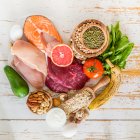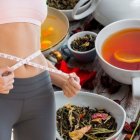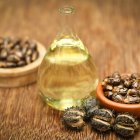Related articles
-
 Ever Wondered How to Make Paneer at Home? Here is the Complete Guide to Take Out Soft and Creamy Paneer from Milk at Home (2021)
Ever Wondered How to Make Paneer at Home? Here is the Complete Guide to Take Out Soft and Creamy Paneer from Milk at Home (2021)
-
 Want More Tantalizing Breakfast Ideas? Here are 6 Scrumptious Egg Recipes for Breakfast That Will Make You Want to Eat Eggs All Day (2020)
Want More Tantalizing Breakfast Ideas? Here are 6 Scrumptious Egg Recipes for Breakfast That Will Make You Want to Eat Eggs All Day (2020)
-
 How to Increase Weight: Foods to Include in Your Diet for Your Weight Gain Journey + Tips for Gaining Weight (2020)
How to Increase Weight: Foods to Include in Your Diet for Your Weight Gain Journey + Tips for Gaining Weight (2020)
Benefits of Vitamin D
Vitamin D, also known as the sunshine vitamin because of its property to be soaked by the body through sunlight, is an important nutrient to keep you healthy. Its main purpose in your body is to act as a catalyst for calcium absorption, which in turn keeps your bones and teeth strong and healthy. Calcium is also vital for bone growth and bone remodelling (removal of old bone tissues and the formation of new ones). Hence, a lack of vitamin D can lead to weak, misshapen or thin bones. Apart from strengthening your bones, vitamin D also has other major benefits for your body. Listed below are some of the important benefits of vitamin D for your body:
- Helps Strengthen Muscles: Apart from giving strong bones, vitamin D is also essential for strong muscles and the lack of it can lead to weak muscles, which can result in accidental falls. This makes vitamin D especially important for the elderly as they are more susceptible to the risk of falls which may lead to disability and even death in some cases.
- Supports the Immune System: Vitamin D can fight harmful bacteria and viruses, thus supporting the immune system. Researchers are also studying the role of vitamin D in viral infections like influenza and coronavirus, and have found positive results till now, though more studies are required to reach on a conclusion.
- Strengthen Oral Health: As vitamin D helps your body to absorb calcium which is a vital element for your teeth and gum health, it lowers the risk of tooth decay and gum problems. Further, it also acts as an anti-inflammatory agent, thus helping in the growth of anti-microbial peptides.
- Can Help Treat Hypertension: A study suggests that vitamin D deficiency even for a short period may lead to increased BP. Thus, the researchers suggested that vitamin D plays an important role in the treatment of hypertension.
- Helps You Lose Weight: A study done in 2009 on a group of overweight women with low calcium levels revealed that those who took a daily dose of vitamin D with calcium were more successful in reducing weight as compared to those who were given a placebo supplement.
- It Helps Fight Depression: We know that the sun can uplift your spirits and surprisingly, vitamin D can also have the same effect. Studies till now suggest a strong relationship between depression and vitamin D deficiency, though more research is needed.
- Other Benefits: Vitamin D has also shown significant improvement in slowing or preventing the development of cancer cells and more research to prove these benefits are underway.
Symptoms and Problems of Vitamin D Deficiency
There are a few easy to understand symptoms and problems associated with deficiency of vitamin D. Moreover, there are a few risk factors which can lead to vitamin D deficiency, the major ones are – having a dark skin tone, being overweight, being elderly, not eating adequate dairy or fish, staying indoors, always using sunscreen when going out during the day and living at a place which is far from the equator where sun exposure is limited. The signs that you are suffering from vitamin D deficiency include:
- Getting Sick Often: If you fall sick or are infected with cold or flu often, then it can be an indication of a weak immune system which can be due to lack of vitamin D in your body.
- Fatigue and Always Feeling Tired: If you feel tired most of the time and have frequent episodes of fatigue, then vitamin D deficiency can be one of the reasons and you should get it checked.
- Back and Bone Pain: As vitamin D is an important nutrient for the consumption of calcium in your body, frequent pain in your bones or back can be a sign of the lack of vitamin D.
- Depression: Lack of vitamin D can be one of the major contributing factors for depression. Some studies have found improvement in people suffering from depression after taking vitamin D supplements. Though, always consult your physician before taking such a supplement.
- Slow Healing of Wounds: Results of a study mentioned that vitamin D is helpful in the formation of compounds essential for the formation of new skin as a part of the healing process after an injury or a surgery. So if your wounds are taking longer than usual to heal, then you should get your vitamin D levels checked.
- Other Symptoms: Some of the other symptoms are bone loss, hair loss and muscle loss which can be a warning sign that you are suffering from vitamin D deficiency.
How to Get Vitamin D: Know the Best Sources Here!
As per a recent study, almost 70–90% of Indians are suffering from vitamin D deficiency, and among them a significant number of people are found to be suffering from DM type 2 and hypertension. Though it’s a surprise finding for a country like India where sunlight is in abundance, this also shows the lack of awareness around vitamin D and its importance for your health. Vitamin D can be derived from natural sources and supplements as well. In this section we will discuss the natural ways to get vitamin D.
Soak Up the Sun
Contrary to popular beliefs, soaking the sun between 10 a.m. to 3 p.m. provides the maximum amount of vitamin D as compared to early morning sunrays. To get an adequate amount of vitamin D from the sun, you need to expose plenty of skin to sunlight. You can keep your arms, legs, abdomen, back, etc. exposed to the sunlight for 15–30 minutes so that your body can produce enough amount of vitamin D. You can wear shorts, tank tops, etc. during this sunbathe and do remember to cover your face and eyes with a hat and goggles.
Yogurt
Yogurt is a dairy product rich in calcium and is easier to digest as compared to milk. The calcium present in yogurt along with vitamin D present in your body acts as a potent combination for your health. Yogurt or curd has good bacteria which is good for your gut health and promotes digestive enzymes in the stomach. It also strengthens immunity by fighting with the bad bacteria in your gut. A cup of yogurt (250 gm) contains 275 mg of calcium which is close to the amount your body needs every day to maintain bone density and strengthen them as well.
Vitamin D Fortified Milk
Although milk naturally doesn’t contain vitamin D, most of the packaged milk manufacturers have started adding vitamin D into their packed milk. In a few countries like Sweden and Canada, vitamin D has to be added to cow’s milk as per the law. In India, FSSAI has set standards of milk fortification for co-operative and private dairies and they should fortify the milk with vitamin A and vitamin D. FSSAI has also introduced a logo denoted by F+ which is a symbol of the fortified products. Vitamin D, when gets added to the natural calcium present in the milk, is quite beneficial for your health. You can check the detailed guidelines and dairies fortifying their milk as per FSSAI standards here.
Vitamin D Fortified Orange Juice
Milk fortified with vitamin D may not provide an adequate amount of the vitamin required for the body if taken in little amounts, and if you are lactose intolerant, then you may not be able to consume milk. To counter this and get the minimum required amount, vitamin D fortified orange juice can be introduced in your breakfast. A 12-week study done on a group of adults showed that the vitamin D levels in them increased significantly when they were given vitamin D induced orange juice on a daily basis.
Fatty Fish and Seafood
Fatty fish and seafood can serve as an excellent natural source of vitamin D and though the percentage of vitamin D may vary for different types of fishes and seafood, they do contain a good amount of vitamin D. Some such aquatic creatures and fishes with high vitamin D content are – wild-caught salmon, mackerel, tuna, shrimp, oysters, anchovies and sardines. A couple of these foods are also rich in omega-3 fatty acids which are considered good for your heart.
Mushrooms
Mushrooms are a complete plant-based resource of vitamin D as they can produce vitamin D on their own like humans. Wild mushrooms or mushrooms treated with UV light (not the commercially produced mushrooms with little exposure to sunlight) produce vitamin D2. Though your body produces vitamin D3, studies suggest that vitamin D3 can also elevate the vitamin D levels in humans. Always purchase wild mushrooms from a trusted supplier as some varieties of wild mushrooms are poisonous in nature.
Egg Yolks
Pastured eggs (eggs produced from chickens who are allowed to roam free in the open and eat insects and plants with some commercial food) and eggs from chickens who are fed with vitamin D enriched poultry, are a good source of vitamin D, especially the yolk part. The quantity of vitamin D present in the yolk may vary though based on the above-mentioned factors.
Foods Fortified with Vitamin D
As vitamin D is not present in a wide range of eatables, thus to provide a sufficient amount of vitamin D in your food, many food staples and drinks are often fortified with this vitamin. The major ones are – cow’s milk, certain flavoured yogurts, ready to eat cereals, orange juice and tofu. While purchasing a food item, you can check the ingredients list on the pack to find out if it’s fortified with vitamin D.
Vitamin D Supplements
The easiest and most common way to get vitamin D is to take supplements. You should consult with your doctor on the best suited dosage for you. In general, vitamin D intake of 1000–4000 IU (international units) on a daily basis is sufficient for most adults. Ensure you take it regularly and as per your doctors advice so your levels remain at a healthy level.
Vitamin D Rich Recipes
Some of you may not have the time to keep a check of the food items and what vitamins or nutrients they contain. An easy way to induce vitamin D in your diet is to include recipes enriched with vitamin D in your diet plan. Given below are a few such recipes which have vitamin D in abundance:
Masala Chaas
For preparing Masala Chaas, you require:
Ingredients:
- 1 Cup curd
- 2 tsp chili (chopped)
- 1 tbsp coriander (chopped)
- 2 tbsp black salt
- 1 tbsp salt
- 1 pinch chaat masala
- ½ cup water
Method:
- Add the chopped coriander, chopped chili and curd in a big bowl, add black salt and salt and mix it thoroughly.
- Blend the mixture to have a perfect consistency and transfer to a pitcher.
- Pour it in a glass, add the chaat masala and garnish with coriander leaves before serving.
Tofu Fruit Salad
Ingredients:
- ½ papaya (peeled)
- ½ pineapple (peeled)
- 1 pear
- 1 apple
- 1 cup silken tofu
- 4 cherries
- ½ tsp stevia
- 4 mint sprigs
Method:
- Blend the silken tofu and stevia in a blender.
- Dice the papaya, pineapple, pear, and apple.
- Keep the diced fruits in a deep bowl and top up with the creamed tofu.
- Garnish with the mint sprigs and serve fresh.
Smoked Salmon Sandwiches
Ingredients:
- 1 slice smoked salmon
- 1 piece lettuce
- 1 tsp scrambled egg
- 2 pieces of bread (cut in round shape)
- Olives, dill, and capers for garnish
Method:
- Cut a thin and long piece from the slice of salmon.
- Keep the lettuce piece on the bread, arrange the scrambled egg over the lettuce, wrap with a piece of salmon and cover with the second bread.
- Decorate the top of the sandwich with finely chopped olives, dill, and capers.
Chilled Mushrooms and Capsicum
Chilled Mushrooms and Capsicum can be used as an appetizer, starter or even as a salad. You would require:
Ingredients:
- 1 cup capsicum (thinly sliced)
- ½ cup onions (thinly sliced)
- 2 tbsp coriander leaves (chopped)
- 2 cups mushrooms (thinly sliced)
- Green chilies (finely chopped)
- ¼ cup cream
- 1 tsp cumin seeds
- ½ tsp mustard powder mixed with cream, vinegar and cumin
- ¼ tsp ground black pepper
- 1 tbsp oil
- Few mint leaves for garnishing
Method:
- To start making the recipe, heat the oil in a large pan and add the cumin seeds.
- When the cumin begins to splutter, add the onions and sauté over high heat until they turn translucent.
- Now add the mushrooms and capsicum and stir over high heat until the veggies are mixed well and look wet.
- Now turn off the stove and let the mixture cool down to room temperature.
- Then add the cream mixture, green chilies, and coriander into it and chill in the freezer for some time.
- Then transfer it into a serving tray, garnish with mint leaves and serve chilled.
Related articles
-
 Ever Wondered How to Make Paneer at Home? Here is the Complete Guide to Take Out Soft and Creamy Paneer from Milk at Home (2021)
Ever Wondered How to Make Paneer at Home? Here is the Complete Guide to Take Out Soft and Creamy Paneer from Milk at Home (2021)
-
 Gained Extra Weight in the Lockdown? Best Slimming Tea to Get in the Right Shape and Live a Healthier Life
Gained Extra Weight in the Lockdown? Best Slimming Tea to Get in the Right Shape and Live a Healthier Life
-
 From Usage in Skincare to Treating Wounds Quickly, Castor Oil Has a Lot of Applications You May Have Never Heard of: Benefits of Using Castor Oil (2021)
From Usage in Skincare to Treating Wounds Quickly, Castor Oil Has a Lot of Applications You May Have Never Heard of: Benefits of Using Castor Oil (2021)
-
 जिम जाने के लिए चुने यह 10 2020 के सबसे बेस्ट जिम बैग्स जो है दिखने में बेहद शानदार और बेहतरीन। साथ में कुछ सुझाव और अन्य जानकारी ।(2020)
जिम जाने के लिए चुने यह 10 2020 के सबसे बेस्ट जिम बैग्स जो है दिखने में बेहद शानदार और बेहतरीन। साथ में कुछ सुझाव और अन्य जानकारी ।(2020)
-
 Get That Well Toned and Perfectly Sculpted Body in the Comfort of Your Home. Your Quick Guide to the Best Home Gym Equipment in India and Why You Need to Get One Now (2021)
Get That Well Toned and Perfectly Sculpted Body in the Comfort of Your Home. Your Quick Guide to the Best Home Gym Equipment in India and Why You Need to Get One Now (2021)
Vitamin D is Extremely Crucial for Your Health
As would have been evident by now, vitamin D is crucial for your health and you can very easily make it a part of your daily diet. We hope this BP Guide would have helped you understand everything about this crucial vitamin and also in deciding which recipe rich in vitamin D you would like to try out first. Stay connected with us for more such engaging content.